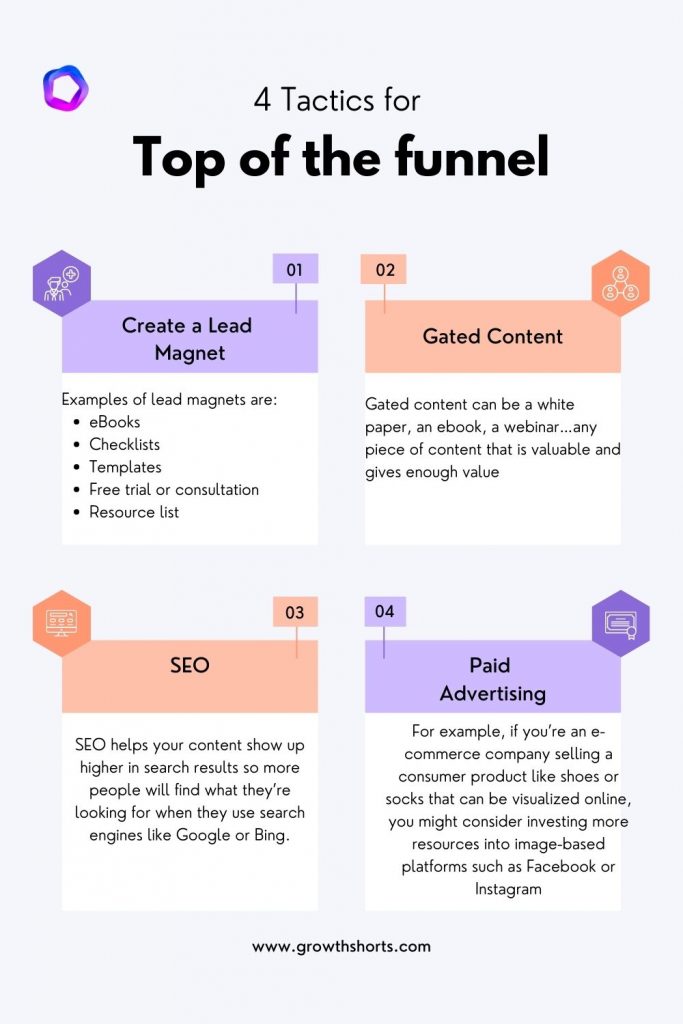Find out everything you need to know about Top of Funnel Marketing, from how to determine the best time to begin investing in it, to how to find the right influencers for your brand.
Top-of-funnel marketing (sometimes called TOFU, for short) is the first point of contact with potential customers. At this stage, your goal is to reach as many people as you can and drive them through the funnel (more on that in a moment). Top-of-funnel marketing is often less expensive than other types of marketing because it’s designed to be mass market.
However, top-of-funnel marketing tends to be less effective than bottom-of-funnel or middle-of-the-funnel strategies like retargeting ads. That’s because the people at the top of your sales funnel are still learning about products and solutions like yours—and they aren’t ready to buy just yet.

Recommended read
- Marketing funnel
- The social media marketing funnel
- Content marketing funnel
- Email marketing funnel
- Top of the funnel marketing
- eCommerce marketing funnel
The importance of top-of-the-funnel marketing
Top-of-funnel marketing is important because it helps you attract more prospects. When someone stumbles upon your content and realizes they have a problem you can solve, they’ll start to see your brand as a source of information. In turn, this will encourage them to view your company as an industry leader and thought leader in the field — two factors that can help you grow your buyer personas and increase brand awareness. The more value you provide to people at the top of the funnel, the easier it will be for qualified leads to progress down the sales funnel.
Another critical aspect is that top-of-funnel marketing allows you to strengthen your brand identity and generate content targeted toward specific keywords and niche audiences. With targeted copy, you can increase search engine optimization (SEO) efforts and nurture leads down into the middle of the sales funnel with relevant promotions.
Top of Funnel Marketing ToC
Create content for every stage in the buyer’s journey
The buyer’s journey refers to the process that leads a person to purchase something. It starts with awareness (or recognition of a problem), continues through consideration, and ends with decision-making. Each stage comes with its own set of challenges and opportunities, which can be addressed by high-quality content:
Awareness content is designed for people who are just starting to realize that they have an issue, middle-of-the-funnel content helps people find solutions, bottom-of-the-funnel content focuses on persuading people that your solution is the best one, and top-of-the-funnel content focuses on helping people understand their current situation so they can determine if there even is a need for change.
Top of funnel marketing tactics
Here are some of the best ways to boost your TOFU marketing efforts:
A strong marketing mix includes both top, middle and bottom of funnel strategies.
You’ve probably heard of top of funnel marketing. Maybe you even know what it is, but aren’t exactly sure how to use it. Or maybe you have some questions about what top of funnel marketing is and need a little bit more information.
To understand the concept of top of funnel, imagine if a user’s awareness about your company was represented by a bucket. The top-of-funnel is the widest part at the very top—think of this as when they’re first introduced to your brand or product. The bottom-of-funnel is the smallest part at the bottom—where users are ready to buy, register, or sign up for what you’re offering.
Top-of-funnel marketing tactics are ways to build brand awareness and generate interest among your target audience; middle-of-funnel tactics are ways to establish yourself as a leader in your industry; bottom-of-funnel tactics are ways to convert leads into customers.
10 Top of Funnel Marketing Tactics
Create a Lead Magnet
A lead magnet (a.k.a. an opt-in bribe) is a free or low-cost offer that you give to visitors in exchange for their contact information. Lead magnets can be anything from a quick PDF checklist to an exclusive webinar, with the goal being to attract your target audience and collect their contact info so you can deliver the offer and convert them into leads.
Here are some examples of tried and true lead magnets:
Gated Content
Gated content is the content that you want your potential leads to give their information in order to access. It’s valuable, it’s not easily accessible, and it’s something that your potential lead will want to see. Gated content can be a white paper, an ebook, a webinar…any piece of content that is valuable and gives enough value to your customer that they are willing to give up their information for it.
Blogging
Blogging is the most fundamental piece of content marketing in the world. It’s a great way to spread your brand story and build trust with your audience. It can also help with SEO and social media marketing because it gives you plenty of content to share that drives traffic back to your site. Blogging doesn’t have to be onerous. You can brainstorm blog topics all at once, then schedule a week’s worth of posts ahead of time so you’re never scrambling for something new to write about. And don’t worry if the first draft seems unpolished—your blog doesn’t need to be perfect right away. Once you feel like you’ve got enough published material, browse through it for opportunities to repurpose existing content into long-form guides or videos.
Email Marketing
Email marketing is a cost-effective online way to generate leads and build relationships with your audience. If you have an email list, you have an ongoing conversation with individuals who have already expressed some interest in what you do. With the right strategy, email marketing can also be a powerful tool for nurturing leads and keeping engaged customers coming back to your brand.
If you’re new to email marketing, start by taking the time to understand your audience. Figure out what they want most from you and deliver it. Also, think about what they’d find valuable—like interesting information or awesome promotions—and include those things in your emails.
Social Media Marketing
SEO
Search Engine Optimization (SEO)
We’ve all been there. You’re looking for a resource on the internet, so you type in a few keywords and hit “Enter.” Then you wait.
You see the first page of results and think “Who wrote this? It looks nothing like what I was looking for…” You head to page two, and then page three, hoping that somebody out there got it right. But then you realize that either nobody has written about your topic before or that all possible resources have already been filtered out by Google algorithms. This can be incredibly frustrating—and it makes you less likely to trust Google in the future!
Fortunately, when people conduct searches on Google they usually get relevant results—but only because most websites have done some optimization work behind the scenes to make sure they appear high in search engine rankings. This is called SEO—it stands for Search Engine Optimization, and it helps your content show up higher in search results so more people will find what they’re looking for when they use search engines like Google or Bing.
Webinars and Events
Webinars and events are a great way to build brand awareness. You’re providing unique content that can help grow your audience, establish you as an expert or thought leader, and build trust with potential customers.
Here are some reasons why webinars are an effective way to generate leads:
- They take less time than writing a blog post.
- They foster deeper relationships because they give your company a voice and personality.
- They allow you to show off your knowledge of the subject matter rather than just telling people what they should know.
Infographics and Slideshares
You can increase engagement with your content by adding visual elements to it. Infographics are a great way to show off stats and data, while slideshares are perfect for visually presenting a specific topic. Both of these kinds of content can easily be embedded in other posts, allowing them to live across the web and increase in visibility over time. This also makes both types of content highly shareable on social media.
Offline Marketing
Direct Mail
Although it’s more expensive than email, direct mail is still a viable option for many businesses. When done correctly, it can be an effective way to advertise your company to potential customers, especially if you know what you’re doing and have the right tools.
Trade shows
Trade shows are another great opportunity to meet people who could be interested in your product or service. You can also set up booths at these events, which is a great way to show off their products and give out free samples. You can also use trade shows as an opportunity to get feedback from potential customers, which can help you adjust your marketing strategy accordingly.
Posters and Flyers
Poster boards are a great way to advertise their business on the cheap. They’re easy to create yourself or purchase online and then put up wherever there’s foot traffic (in stores, on street lamps, etc.). These days there are many options for printing posters that look professional at home using your own printer or one from Kinkos.
For example, if thy don’t have a store but would like people in the neighborhood where thy conduct most of their business to know about them? Just hang a poster board with some info outside of the local coffee shop! It’ll probably cost less than $10 but could bring in new customers who never knew about them before seeing this simple sign! (and now we’ve answered why am I writing this article).
You can also print flyers with information about what they do and distribute them by hand or leave them at other businesses where someone might pick one up while they’re waiting for their coffee order).
Paid Advertising
The most popular forms of paid advertising are Google Ads, Facebook Ads, LinkedIn Ads, Instagram Ads, Twitter Ads, and display ads. In order to attract potential customers in the awareness stage of their buying journey, you might want to experiment with different types of ads on each platform to see which ones generate the most engagement and leads.
For example, if you’re an e-commerce company selling a consumer product like shoes or socks that can be visualized online, you might consider investing more resources into image-based platforms such as Facebook or Instagram. If your product is geared towards professionals who typically use search engines (like Google) to find new products and services for their businesses, then a text ad on Google might be the better option for capturing leads and increasing brand awareness.
Create value for your potential leads
One of the main things you’ll want to avoid is making an offer that’s completely unrelated to the product you’re selling. For example, if you use a lead magnet that has nothing to do with your product, then people will be disappointed when they download it and find out that there’s no clear connection between the two. This can cause them to unsubscribe or not even open your future emails.
It’s also important that any gifts or freebies you give out are related in some way to what they’ll be paying for later on down the line. If someone opted-in because they were interested in learning how to bake a perfect pie crust, they might feel cheated if all they get is a recipe for lemonade instead! Be sure that any leads’ expectations are met when they sign up so there will be no surprises when it comes time for them to make their final purchase decision.
